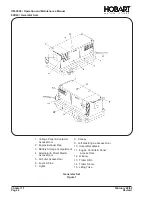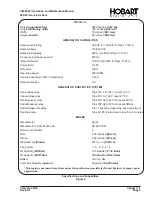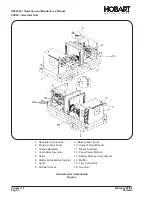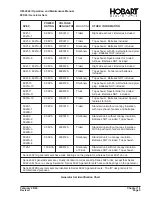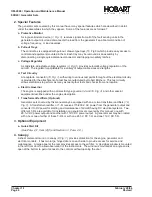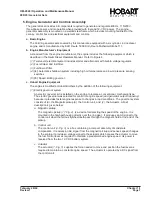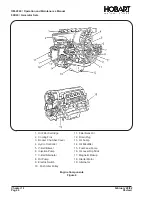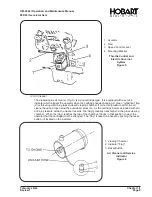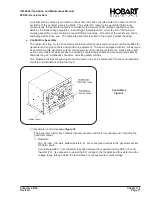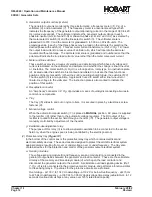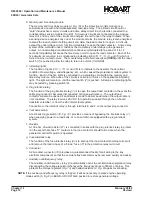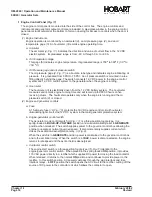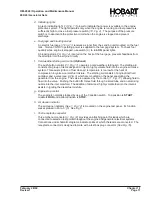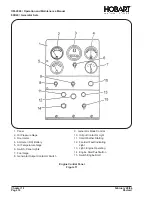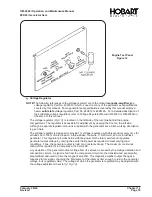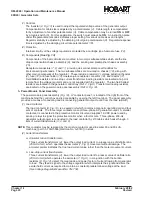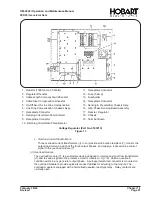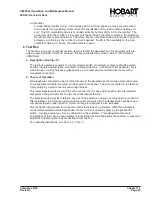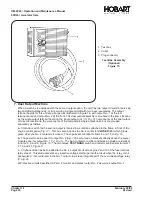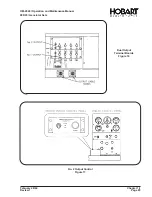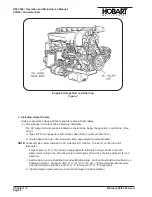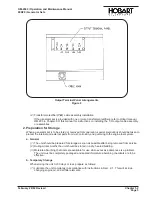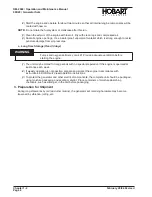
f. Engine Control Panel
(Fig. 11)
The engine control panel is mounted into the side of the control box. The engine controls and
instruments and generator output controls are included. A plexiglass window in the engine control
panel door slants outward at the bottom to form an opening for access to controls when the door is
closed.
(1)
Engine Instruments
Engine operation is monitored by an ammeter
(4),
an oil pressure gage
(2)
, and an oil
temperature gage
(5)
. An hourmeter
(3)
records engine operating time.
a. Ammeter
The ammeter
(4, Fig. 11)
indicates the direction and value of current flow in the 12 VDC
electric system. Its graduated range is from - 60 A through 0 A, to +60 A.
b. Oil Temperature Gage
This gage (5) indicates engine temperature. Its graduated range is 150
o
to 300
o
F
(50
o
to
150
o
C).
c. Oil Pressure gage and oil pressure switch
The oil pressure gage
(2, Fig. 11)
is a bourdon tube type and indicates engine lubricating oil
pressure. It is graduated from 0 PSI to 75 PSI. An oil pressure switch is mounted in a tee
fitting directly behind the gage. The switch connects 12-V DC power to the engine control
system and 12-V DC control system to the generator when the engine is running.
d. Hourmeter
The hourmeter
(3)
is electrically driven from the 12 VDC battery system. The hourmeter
measures and records engine running time and will record up to 9999.9 hours on five
revolving drums. The hourmeter operates only when the engine is running and the oil
pressure switch
(2)
is closed.
(2)
Engine and generator controls
a. Fuse
A 15-ampere fuse
(16, Fig. 10)
protects the 12-VDC engine control circuit hourmeter,
illuminating light circuit, and 12-VDC system in the main generator protective system.
b. Engine-generator control switch
The generator mode control switch
(9, Fig. 11)
is a three-position toggle type. It is
spring-loaded in BUILD-UP-VOLTAGE position, and will automatically reset to GENERATE
position when released. The switch supplies power to the governor control box allowing the
engine to operate at normal governed speed. It also momentarily supplies current which
closes the excitation-deenergization relay,
(3, Fig. 9).
When the switch is in GENERATE position, power is maintained to the governor control box
and to the excitation relay. When the switch is in IDLE, power is disconnected so the engine
returns to idle speed and the exciter field is deenergized.
c. Contactor control switch
The engine start switch is a three-position toggle type
(15, Fig.11)
identical to the
engine-generator control switch. When placed in the spring loaded ON position, it provides
115-VAC power directly to a rectifier which supplies DC power for closing the load contactor.
When released, it returns to the normal ON position and continues to provide power to the
rectifier. In this switch position, AC power must pass through the plug interlock and fuse
interlock relays. In OFF position the switch opens the AC circuit to the rectifier, cutting off the
source of DC power to the contactor coil which allows the contactor to open.
OM-2040 / Operation and Maintenance Manual
90D20 / Generator Sets
Chapter 1-1
February 28/94
Page 16
Revised
Summary of Contents for 6921 Series
Page 2: ...This page intentionally left blank ...
Page 223: ......
Page 224: ......
Page 225: ......
Page 226: ......
Page 227: ......
Page 228: ......
Page 229: ......
Page 230: ......
Page 231: ......
Page 232: ......
Page 233: ......
Page 234: ......
Page 235: ......
Page 236: ......
Page 237: ......
Page 238: ......
Page 239: ......
Page 240: ......
Page 241: ......
Page 242: ......
Page 243: ......
Page 244: ......
Page 245: ......
Page 246: ......
Page 247: ......
Page 248: ......
Page 249: ......
Page 250: ......
Page 251: ......
Page 252: ......
Page 253: ......
Page 254: ......
Page 255: ......
Page 256: ......
Page 257: ......
Page 258: ......
Page 259: ......
Page 260: ......

